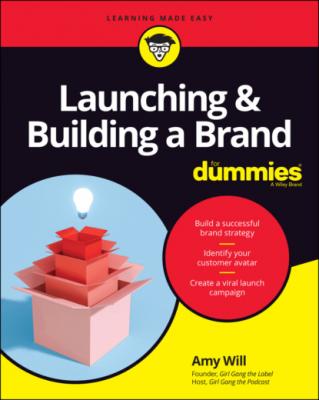ТОП просматриваемых книг сайта:
Launching & Building a Brand For Dummies. Amy Will
Читать онлайн.Название Launching & Building a Brand For Dummies
Год выпуска 0
isbn 9781119748052
Автор произведения Amy Will
Жанр Малый бизнес
Издательство John Wiley & Sons Limited
If you’re in a hurry because you’re up against a deadline, or if you need urgent help dealing with a branding issue, turn to the table of contents (at the beginning of this book) or the index (at the end). Either will point you in the right direction.
Keep in mind that branding isn’t a linear process. You can start just about anywhere. What’s important is the collective impact of everything you do to promote your brand.
Part 1
Getting Started with Branding
IN THIS PART …
Get a quick primer on branding, including the purpose of branding, the different types of brands, what brand architecture is all about, deciding when creating a brand makes sense, and a bird’s-eye-view of the 10-step branding process.
Build a brand from the ground up, starting with deciding what you’re going to brand and identifying a market niche and moving on to the process of creating a business around your brand and securing the money to finance it.
Position and define your brand, which involves differentiating your brand from everything else already out there, deciding what your brand’s essence will be, and coming up with a clever, catchy name for your brand that also clearly describes it.
Identify your branding goals, build a plan to meet those goals, and measure the success of your branding activities, so you can make data-driven changes to your strategy and tactics.
Define your customer avatars (after, of course, figuring out what the heck a customer avatar is). It all starts with getting to know the people in your target market and then describing them as a group in 50 words or less.
Chapter 1
Wrapping Your Brain around Branding
IN THIS CHAPTER
Because you’re reading this book, I can safely assume that you want to build and launch a brand. You already have a general idea of what that entails. You create something that people value: a business, product, service, worthy cause. Then you position it as being something unique so that people will do what you want them to do: buy your product, subscribe to your service, join your cause, listen to your podcast, vote for you, whatever your goal may be.
That’s what branding is all about, but to do it, you need to take a deeper dive, which is why you’re reading this book. In subsequent chapters, I take you on that deeper dive. In this chapter, I encourage you to wade in slowly, building overall understanding of branding so that when you encounter the more detailed topics, you’ll know how they fit into the overall picture.
Consider this chapter to be Branding Orientation Day. Here, I introduce you to the topic, explain some key concepts, and lead you through the ten-step process for building and launching a brand.
Understanding What a Brand Is and Does
A brand is a mental construct that identifies an entity (a business, product, service, organization, or person) as something special. As a mental construct, a brand is intangible; you can’t see, hear, touch, smell, or taste it. But it can have a powerful impact on how people perceive and feel about something, such as an organization, person, or product.
Although a brand itself is intangible, several tangible items contribute to creating a brand, including the following:
Brand name
Mission and values (for corporate or individual brands)
Personality
Distinctive features (quality, design, value)
Visual design elements (logo, color, typography, tagline, images, packaging)
Content (website, blog posts, social media, images, video, white papers)
Customer experience (location atmosphere, convenience, customer service)
All these elements and others contribute to the perception consumers have of the brand. Just think about one popular brand: Coca-Cola. Its brand name, red-and-white Spencerian script, and unique bottle shape are recognizable everywhere in the world and have been for more than a century. But although the company is built around soft drinks, its marketing focuses on selling happiness and camaraderie and on eliciting a strong emotional response from customers.
Creating a strong emotional bond with customers is the primary purpose of a brand. But a brand also serves other purposes, including the following:
Differentiating an organization, product, or person from any competitors
Building trust
Building loyalty
Establishing credibility
Motivating customers to take action (buy a product or service, join a cause, vote for a candidate, watch a video, and so on)
Building equity or value that can ultimately be sold
BRANDS VERSUS COMMODITIES
One way to think about what a brand is and does is to compare it with a commodity:
Commodities are indistinguishable goods and services that serve the same purpose regardless of who makes them, such as gasoline, batteries, dishwashing detergent, coffee beans, Internet bandwidth, and vacuum cleaners. Unless you have a good reason to buy one commodity instead of another, you buy the cheapest one.
Brands are offerings that are different in some way that matters to customers or clients, such as Shell gasoline, Energizer batteries, Dawn dishwashing detergent, Starbucks coffee, Verizon Internet service, and Shark vacuum cleaners. You’re willing to pay more for your favorite brands because they’re different and better in your mind than the competition.
If you’re not a brand, you’re a commodity, and if you’re a commodity, the only way you can compete in your market is to offer the lowest price.

